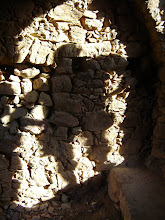When Henry Hudson weighed anchor off Manhattan Island in 1609 to sail up the river that bears his name in a vain attempt to find a North-West Passage, little could he have realised that this safe anchorage would develop into an iconic world city that celebrates its 400th birthday this year. Hudson was in the employ of the Dutch East-Indies Company, and later, a trading settlement was established here under the auspices of the newly established Dutch West-Indies Company. The anniversary is being marked by a number of events on both sides of the Atlantic in 2009, not least an exhibition at the Rijksmeuseum in Amsterdam: Return to Manhattan (Weerzien met Manhattan).
It was the last day of the exhibition on Whit Monday, so I took my chance and travelled up to the Dutch capital. Having been to New York 2 years ago and having read up on its history, I went in eager anticipation. It was a great day out but the exhibition itself was disappointing with just a handful of exhibits on display - even the Nightwatch covered more surface area - and no commemorative material whatsoever, but for a nostaligic, Dutch-centric Elsevier publication: Ons Amerika. 400 jaar Nederlandse Sporen in de Verenigde Staten. This despite the fact that Russell Shorto's best-selling and authoritative book on the early history of New York (i.e. Nieuw Amsterdam) had been published 5 years previously (and been translated into Dutch): The Island at the Centre of the World.
Perhaps a visit to the Henry Hudson 400 site would have sufficed.
Until recently, little had been known about this fledgling Dutch colony that marked the beginning of the Big Apple. Much of the early documents pertaining to Nieuw Nederland had been gathering dust in the New York State archives in Albany (formerly Fort Orange). What's more there was no one able to decipher, transcribe and translate the handwritten Dutch documents into English. That was until 35 years ago, when historian Charles Gehring decided to start examining these early records. Much of his painstaking research forms the basis for Shorto's intriguing insight.
New facts are being uncovered all the time about this fascinating period, which has so far been treated as a footnote of history. It can be argued that the founding of New York was of even greater significance than the landing of the Pilgrim Father's at New Plymouth, but it is this latter event (in 1620) which is marked by Americans in Thanksgiving as the founding of the American Dream (of course, there is a Dutch connection here too).
Even the vast majority of Americans are unaware that such time-honoured New York place names such as Harlem, Brooklyn, Jonkers and Flushing have Dutch origins (Haarlem, Breukelen, Jonkheer and Vlissingen), not to mention Stone Arabia in the Mohawk Valley, which may be a corruption of Stenen Rapen. Other place names, such as Amsterdam, Rotterdam, Rensselaer and Watervliet, in upstate New York are less subtle reminders that this was once a Dutch colony. A form of Dutch was spoken here until the end of the 19th century before it ultimately died out. In the meantime, English adopted Dutch words some of which are in widespread use today, such as cookies, boss, cole-slaw and stoop.
The pioneering Dutch rulers were eventually forced out of Nieuw Amsterdam by the English, who not only had expanding colonies to the north (New England) and south (Virginia), but who were probably more committed to investing resources in North America (whilst the Dutch focused on their East Indian possessions). Ultimately of course, the English themselves were ran out of New York by the revolutionaries, but that's another chapter of history altogether.
Perhaps more material will be unearthed in future which will shed more light on the subject. But one thing still seems to be indisputable: it was an Englishman who is celebrated as the founder of modern-day New York.
A Dutch book on the origins of New York is to be published shortly, the author having been responsible for the organisation of the exhibition at the Rijksmuseum:
Nieuw Amsterdam / New York by Martine Gosselink
Other popular histories have been written about other early American colonies, most notably:
Big Chief Elizabeth: How England's Adventurers Gambled and Won the New World, by Giles Milton, and
Mayflower: A Voyage to War by Nathaniel Philbrick










